For most people, sunburn is an all-too-familiar experience, one that results from prolonged exposure to ultraviolet (UV) radiation from the sun. The immediate effects are often painful and visible – red, inflamed skin that feels hot to the touch. However, the molecular mechanisms underlying sunburn are far more complex than we might realize. A key player in this process is RNA, which plays a significant role in cellular responses to UV damage. Recent research has revealed that RNA damage could be a central factor in sunburn reactions, making it an important area of study for improving skin health and preventing long-term skin damage, such as skin cancer.
In this article, we’ll explore how UV radiation causes RNA damage, the biological consequences of this damage, and why it plays a crucial role in the sunburn reaction.
The Basics of UV Radiation and Skin Damage

UV radiation is a form of electromagnetic radiation emitted by the sun. It is divided into three categories based on wavelength: UVA, UVB, and UVC. Of these, UVA and UVB are most responsible for the harmful effects on the skin, while UVC is largely absorbed by the Earth’s atmosphere.
When UV rays penetrate the skin, they cause damage to the DNA and RNA in skin cells, leading to a cascade of biochemical events. DNA damage from UV radiation is a well-known cause of sunburn, but recent studies have shown that RNA damage is also an essential contributor to the inflammatory processes that follow UV exposure.
The Role of RNA in Cellular Function
RNA (ribonucleic acid) plays an essential role in the cell by converting genetic information stored in DNA into proteins that carry out various cellular functions. Unlike DNA, which is a stable blueprint, RNA is a transient molecule that is synthesized and degraded as needed. This makes RNA highly susceptible to damage, especially under stress conditions like UV exposure.
One of the key types of RNA that can be damaged by UV radiation is messenger RNA (mRNA), which carries the genetic code from DNA to the ribosome for protein synthesis. Other types of RNA, including ribosomal RNA (rRNA) and transfer RNA (tRNA), are also crucial for protein synthesis, and damage to these molecules can severely disrupt cellular function.
UV Radiation-Induced RNA Damage
When skin cells are exposed to UV radiation, it can lead to both direct and indirect damage to RNA. Direct damage occurs when UV rays directly interact with the RNA molecules, causing chemical modifications such as the formation of pyrimidine dimers. These dimers can distort the RNA structure, interfering with normal cellular processes.
Indirect damage occurs when UV radiation triggers a series of biochemical responses in the cell, including the activation of reactive oxygen species (ROS), which can cause oxidative damage to RNA. These ROS can also damage other cellular structures, including proteins and lipids, leading to inflammation, cell death, and tissue injury.
One of the most significant consequences of RNA damage is the disruption of the normal expression of genes involved in cellular repair, immune responses, and apoptosis (programmed cell death). If the RNA damage is severe enough, it can prevent the synthesis of critical proteins that would otherwise help the cell recover from UV-induced stress.
The Sunburn Reaction: Inflammation and Immune Response
Sunburn is essentially an inflammatory response to UV damage, with the body reacting to the damage caused to its cells. The process involves several key stages, including cellular damage, the activation of immune cells, and the release of pro-inflammatory cytokines.
One of the first signs of sunburn is redness, which occurs as a result of increased blood flow to the affected area. This is followed by swelling, pain, and peeling skin. The immune system is activated in response to the damaged skin cells, and inflammatory molecules such as prostaglandins are released, causing the typical symptoms of sunburn.
RNA damage plays a crucial role in this inflammatory process. When UV radiation causes RNA damage in skin cells, it can trigger the activation of signaling pathways that result in the release of inflammatory cytokines. These cytokines promote the recruitment of immune cells to the site of injury, amplifying the inflammatory response and contributing to the pain and discomfort associated with sunburn.
Moreover, RNA damage can hinder the expression of proteins involved in repairing damaged tissue. This delay in repair mechanisms can prolong the duration of sunburn and increase the risk of more severe skin damage.
The Long-Term Implications of RNA Damage

While the immediate effects of sunburn may be temporary, the long-term implications of UV-induced RNA damage are far more serious. Over time, repeated UV exposure can lead to chronic skin damage, including premature aging (photoaging) and an increased risk of skin cancer.
One of the most concerning long-term effects of UV-induced RNA damage is its potential contribution to the development of skin cancer. UV radiation can cause mutations in DNA, which can then be transcribed into defective RNA, leading to the production of abnormal proteins. These abnormal proteins can disrupt normal cell function, leading to uncontrolled cell division and the development of tumors.
Furthermore, RNA damage has been linked to immune system dysfunction. Chronic UV exposure can impair the ability of the immune system to recognize and eliminate cancerous cells, allowing abnormal cells to proliferate unchecked. This could explain why individuals with a history of frequent sunburns are at a higher risk of developing skin cancer, including melanoma, basal cell carcinoma, and squamous cell carcinoma.
Preventing and Repairing RNA Damage
Understanding the role of RNA damage in sunburn and skin cancer has led to new approaches in protecting the skin from UV radiation and promoting cellular repair. The most effective way to prevent sunburn and RNA damage is by reducing UV exposure. This can be achieved through various methods, such as:
- Using Sunscreen: Broad-spectrum sunscreens that protect against both UVA and UVB rays can significantly reduce the risk of UV-induced RNA damage.
- Seeking Shade: Limiting sun exposure, especially during peak UV hours (10 a.m. to 4 p.m.), can help protect the skin from unnecessary damage.
- Wearing Protective Clothing: Clothing that blocks UV rays, including hats and sunglasses, can provide additional protection against sunburn.
- Topical Antioxidants: Antioxidants like vitamin C and E can help neutralize ROS and reduce oxidative damage to RNA and other cellular components.
In terms of repair, researchers are investigating the development of therapies aimed at enhancing RNA repair mechanisms. By targeting the pathways that detect and repair RNA damage, it may be possible to reduce the long-term effects of UV exposure and prevent the progression of skin damage into more severe conditions, such as cancer.
Also Read:
Conclusion
RNA damage plays a central role in the sunburn reaction, contributing to the inflammatory processes and long-term skin damage caused by UV radiation. Understanding the molecular mechanisms behind RNA damage is essential for developing new strategies to prevent and repair skin damage. As we continue to explore the intricacies of UV-induced RNA damage, we move closer to finding effective ways to protect the skin from harmful sun exposure and reduce the risk of skin cancer. With the right preventive measures, such as using sunscreen, seeking shade, and wearing protective clothing, we can help minimize the harmful effects of UV radiation and safeguard skin health.





